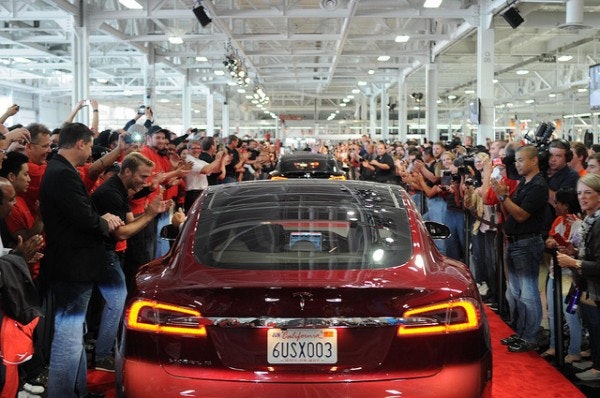In the first part of this two-part series, we looked at how electric cars were very successful in the early years of automotive history. But as paved roads made long-distance travel easier, efficient mass production built the average Joe’s gas powered Model T, and safety issues with gas cars were fixed, electric cars declined in popularity, and turned into a niche product in the decades that followed.

Today, electric cars are seeing a renaissance, with new models being introduced by Nissan, Ford Motor Company (NYSE: F), and the start-up EV maker Tesla Motors Inc (NASDAQ:TSLA). At the same time, new technologies are changing the industry making EVs more viable than ever before.
An electric car’s gas station
According to Fueleconomy.gov, the 2012 Ford Motor Company (NYSE: F) Focus has a range of nearly 350 miles on a tank of gas. The Tesla Motors Inc (NASDAQ:TSLA) Model S with an 85 kWh battery pack has an all-electric range of 265 miles. But the Ford Focus was the best-selling car in the world for 2012, while the Model S still leaves some people with feelings of range anxiety. There probably aren’t many people who need to drive a distance between 265 and 350 miles on a regular basis to justify why range anxiety is only present in the Model S.
The real difference comes from when one goes beyond the range, whether 265 or 350 miles. A Focus can be refilled at any one of the gas stations that blanket North America, and be ready to go with a full tank in less than five minutes. By contrast, there are a far smaller number of electric car charging stations, especially outside California. Even when a Model S does find one, it will take an hour to fully recharge, and that’s only if the station is a Tesla Motors Inc (NASDAQ:TSLA) Supercharging station.
But what if the Model S could be charged in five, or even 10, minutes at electric car charging stations that are as common as gas stations? The time waiting to refuel would be almost exactly the same as the Focus’s, and finding a source of fuel would be easy as well. With the ranges of the two cars not that different, the Focus and the Model S would offer drivers the same absence of range anxiety.
Other electric cars would benefit immensely from quicker charging from more common stations as well. Consider the benefits for the electric car most similar to the Focus: Ford’s Focus Electric. With 76 miles of all-electric range, and no range-extending engine like General Motors Company (NYSE:GM)’s Volt has, many buyers are likely turned off the car due to range-anxiety fears. But with charging stations dotting the landscape, and charging as rapid as refueling with gas, range anxiety would significantly diminish.
Of course, cutting the charging time to 10 minutes would require more technological improvements. But these are already under development, and could begin to see commercialization over the next several years.
Building those stations
As a maker of electric cars and only electric cars, Tesla Motors Inc (NASDAQ:TSLA) is not just waiting for fast charging stations to appear. In a partnership with SolarCity Corp (NASDAQ: SCTY), Tesla is working to build out a network of Tesla Motors Inc (NASDAQ:TSLA) Supercharging stations. The stations are designed to be powered by SolarCity Corp (NASDAQ: SCTY)’s solar panels and will provide free energy to Tesla Motors Inc (NASDAQ:TSLA) owners. Since Tesla CEO Elon Musk is also the chairman of SolarCity the partnership is a natural fit for integration among the Musk companies.
Right now, the stations are rolling out in California and the East Coast, where the partnership is working on developing an electric car corridor. Together, the companies hope to have 100 supercharging stations operational by 2015, in locations across all of North America.
The partnership benefits both Tesla and SolarCity in ways beyond short-term finances. SolarCity’s system of installing solar panels and selling the electricity to the building owner needs clients to continue expanding its business. With each client it gets, SolarCity gets another stream of revenue that could last for decades, thereby providing the company with additional funds for growth. On Tesla’s side, the automaker gets a powerful tool to fight range anxiety and the ability to advertise its name without buying into standard forms of advertising media.
But while 100 Supercharging stations is a great start, it’s nowhere near the number of gas stations across North America. Ultimately, it will take far longer for charging stations to grow in numbers sufficient to compete with gas stations. This owes largely to a vicious cycle: Few electric cars means little demand for charging stations, and a lack of such stations steers people away from electric cars. That cycle’s being broken now, as governments encourage the building of charging stations, and private companies such as Tesla and SolarCity build their own Superchargers.
Gaining acceptance
In 2006, Who Killed the Electric Car? debuted at the Sundance Film Festival. The documentary chronicled the death of the first major wave of electric cars in the late 1990’s and early 2000’s. But just five years later, the same group of people released another film calledRevenge of the Electric Car. In the time between the films, the Tesla Roadster, Tesla Model S, Nissan Leaf, and General Motors Company (NYSE:GM) Volt were all developed, signaling a return of the electric car. Fuel prices also climbed well above their 2006 levels, increasing the economic benefits of EVs, while better battery technology gave EVs greater range, thereby attracting more buyers.
As discussed in this series, electric cars can gain mass acceptance by either using cheaper, better batteries or improving nationwide charging infrastructure. Better batteries could help EVs travel farther between charges, while more common charging stations could greatly reduce range anxiety.
Looking forward, electric cars are taking on the factors holding them back. Battery development could drastically cut prices and increase range over the coming years, and charging infrastructure could make long-distance travel in an EV as easy as in a conventionally powered vehicle.
A growing demand for electric cars is definitely a plus for Tesla, which builds its business on EVs. But it’s less significant for major automakers like Ford. While Tesla could drastically increase sales as it expands its product line, EVs make up only a tiny part of the sales of major automakers. As a result, investors wanting to bet on improvements in EV technology should see whether Tesla Motors deserves a spot in their portfolio.
Alexander MacLennan owns shares of Tesla Motors . The Motley Fool recommends Ford and Tesla Motors . The Motley Fool owns shares of Ford and Tesla Motors .

